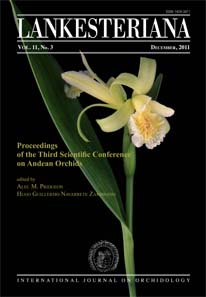How uniform is species diversity in tropical forests?
DOI:
https://doi.org/10.15517/lank.v11i3.18282Keywords:
Orchidaceae, species diversity, sampling effort, tropical forest, BoliviaAbstract
Questions concerning species diversity have attracted ecologists for over a century. One of these factors is the sampling effort - the “botanist effect,” which can be, for example, the number of orchidologists in the region. The sampling effort can also account for the fact that most endemic orchid species are found close to roads, which indicates that orchid diversity may decline from the forest edge towards its interior. Here we tested this hypothesis, using data on orchid species from Bolivia. We found opposite trends in terrestrial and epiphytic species. Both species diversity and number of individuals of terrestrial species declined toward the forest interior. However, for epiphytic species, both species diversity and number of individuals of species increased toward the forest interior. Only because of the prevalence of the terrestrial species did the total number of species and the total number of individuals decline towards the forest interior. Thus, when making conclusions about the trends in orchid diversity towards the interior of the forest, their life mode should be taken into account. The reasons for the trends observed are quite straightforward. Toward the forest interior, density of the trees increases, and therefore the amount of light available on the ground declines. Hence, habitats close to the openings (roads, meadows, fields, etc.) are more suitable for terrestrial species, whereas those deep in the forest interior are more suitable for epiphytic species because of the availability of host trees.
Downloads
Downloads
Published
How to Cite
Issue
Section
License
According to the Open Access policy promoted by the University of Costa Rica, all the papers published by Lankesteriana are licensed under the Creative Commons copyright and can be downloaded free of charge. The journal holds copyright and publishing rights under the CC BY-NC-ND 3.0 CR license.
Before the publication of the materials submitted by the author(s) in LANKESTERIANA, the author(s) hereby assign all rights in the article to the Lankester Botanical Garden.





